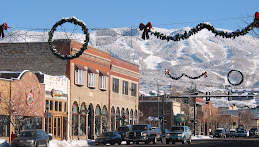Officials want Steamboat 700 village center moved
By Brandon Gee Steamboat Pilot / TODAY
Thursday, February 14,
Steamboat 700 by the numbers
Size: 700 acres
Buildout: 10 to 25 years
Residential units: 1,827 to 2,243
High-density residential units (condos, townhouses, apartments): 45 percent
Small, single-family lots (under 8,000 square feet) or duplexes: 36 percent
Square footage of commercial/nonresidential uses: 272,000 to 331,000
Affordable housing target: 80 percent to 150 percent AMI (area median income)
Permanently deed-restricted housing provided by developer: 20 percent (367 to 448 units)
Topography: Most slopes 5 percent to 15 percent, some 30 percent or more on bluffs and hillsides
“Village centers:” three to four stories
Open space: 221 acres (32 percent)
Trails: 10+ miles
Infrastructure cost: $103 million
Additional off-site automobile trips a day generated: 14,000
— Source: Steamboat 700 Initial Submittal, November 2007
For more information on the Steamboat 700 annexation and development, visit www.yampavalley.info/
steamboat700.asp and www.steamboat700.com.
Steamboat Springs — While much of the discussion about the proposed Steamboat 700 development has focused on housing, city officials also have raised concerns about the development’s commercial components.
In a staff report prepared for Steamboat 700’s pre-application review tonight before the Steamboat Springs Planning Commission, city officials criticize the proposed location of the development’s main village center. Development plans show the village center going in along U.S. Highway 40 at the extreme southeast corner of the 700-acre project. New Victory Parkway, a proposed road that would serve as the development’s main east-west artery, would form the village center’s north boundary.
“The village center is disconnected from the majority of the proposed development,” the city staff report states. “New Victory Parkway should be encompassed within the village center to provide pedestrian connectivity and to ensure that at least a portion of the road operates as a ‘main street’ commercial area rather than a typical suburban arterial.”
Developers warn if they are forced to move the village center, they may lose their ability to provide west Steamboat’s No. 1 commercial need, as identified by a Steamboat 700 survey.
“We’re going to try to get a grocery store,” Peter Patten, a land-use consultant employed by Steamboat 700, said at a meeting last week with Routt County officials. “The grocery store needs U.S. 40 frontage, or it’s not going to happen.”
Patten also said that while the village center is not central in Steamboat 700’s site, it is central to the broader west of Steamboat Springs area.
“The community wants a grocery store,” Danny Mulcahy, Steamboat 700 project manager, said at the same meeting.
Mulcahy also noted two smaller, mixed-use centers that would be dispersed in other areas of the project to serve other neighborhoods. Bill Fox, Steamboat 700’s transportation consultant, said 60 percent of Steamboat 700’s homes would be within a quarter-mile of a mixed-use center.
“It’s a place that’s very walkable,” Fox said.
On Wednesday, Planning Services Manager John Eastman said city staff has not been swayed by the arguments of Mulcahy and his team.
“The key is the village center functions as a pedestrian-accessible experience for a significant portion of the development,” Eastman said.
Nonetheless, Eastman said he is confident the village center issue will be worked out. He said the grocery store argument is a legitimate one.
“We absolutely need a grocery store out there,” Eastman said.
Eastman said the developers and the city are much farther apart when it comes to the issue of affordable housing, but that is a situation that might be changing. Eastman said progress was made in a meeting between city officials, Steamboat 700 and the Yampa Valley Housing Authority on Wednesday.
“We didn’t reach any solutions but at least found some ways that might lead to some solutions,” Eastman said. “I’m a lot more optimistic.”
skip to main |
skip to sidebar



Ski Town USA
Downtown Steamboat
Blog Archive
-
►
2012
(3)
- ► April 2012 (3)
-
►
2010
(5)
- ► December 2010 (1)
- ► February 2010 (2)
- ► January 2010 (1)
-
►
2009
(42)
- ► September 2009 (3)
- ► April 2009 (2)
- ► March 2009 (15)
- ► February 2009 (4)
- ► January 2009 (9)
-
▼
2008
(210)
- ► December 2008 (12)
- ► November 2008 (8)
- ► October 2008 (17)
- ► September 2008 (34)
- ► April 2008 (13)
- ► March 2008 (31)
-
▼
February 2008
(7)
- Ski Area Mountain Upgrades - Intrawest
- Steamboat 700 Village (commercial space)
- Steamboat 700 development team is floating a housi...
- Sidewalk Offer by Ski Corp.
- Trailside Village - 230 new condos in planning
- Iron Horse - Affordable City Housing or Nightly Re...
- Road Access & Congestion - West of Steamboat
- ► January 2008 (25)
-
►
2007
(37)
- ► December 2007 (14)
- ► November 2007 (17)
- ► October 2007 (6)
Subscribe To News
Learn more about Steamboat Springs, CO
About Me

- Michelle Diehl
- To learn more about Steamboat Springs. Visit my website: www.SteamboatDream.com
Thank you for visiting the Steamboat Springs, Colorado, Real Estate News Site
Visit www.steamboatpilot.com for more news.

Ski Town USA